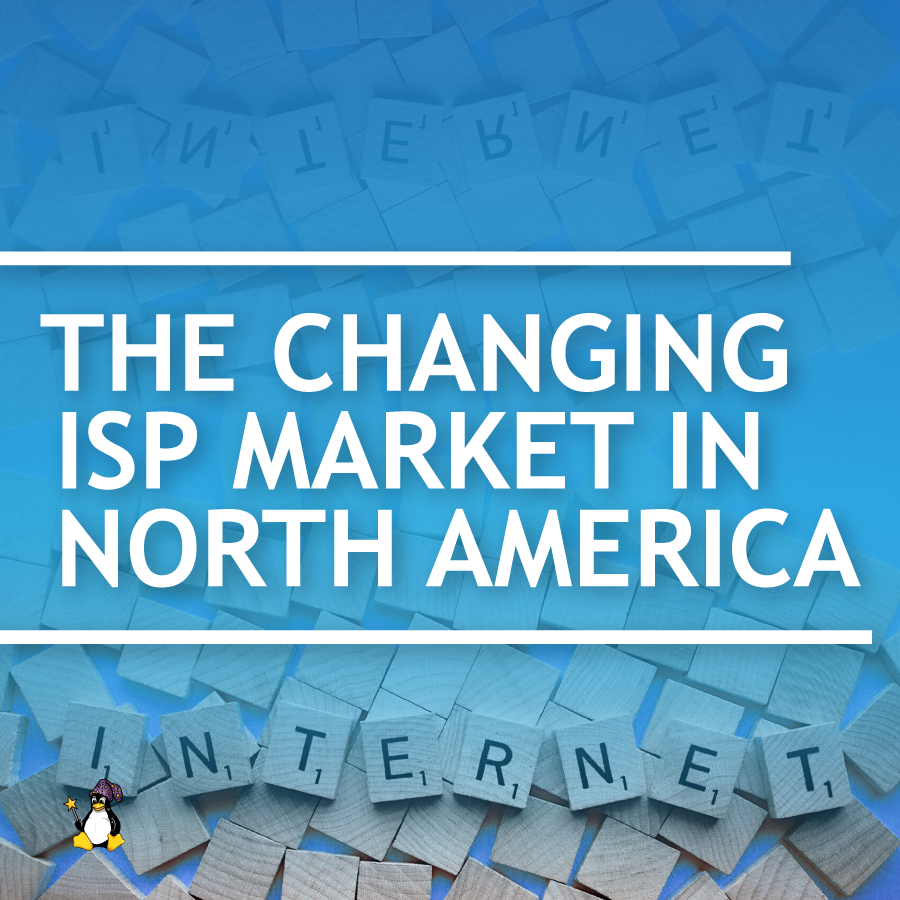The Changing ISP Market in North America
Times have really changed since the dial up days of the 1990’s. Back then, over 10,000 Internet Service Providers offered internet access/connectivity to their customers. Today, only about 2,890 remain. The ISP Market is shifting faster than we can keep up with; so let’s take a look at this changing landscape.
The Shrinking ISP Market
 It really is a “dog eat dog” world out there. With consolidations left and right, sellouts of smaller players, and the disappearance of many independent operators who just can’t compete, getting ahead in the ISP market is no easy task. Since the U.S. population only grows by about 3% annually, ISPs cannot rely on brand new customers simply walking through the door. As an operator, if you’ve promised your shareholders 10% growth in the next year, where are you going to get it? You’re pretty much stuck with two options; absorbing a smaller or less successful provider and acquiring their customers, or by convincing their customers to switch over. With all the recent news about ‘mega mergers‘ lately, it’s not just the small rural telcos and ISPs feeling the pinch.
It really is a “dog eat dog” world out there. With consolidations left and right, sellouts of smaller players, and the disappearance of many independent operators who just can’t compete, getting ahead in the ISP market is no easy task. Since the U.S. population only grows by about 3% annually, ISPs cannot rely on brand new customers simply walking through the door. As an operator, if you’ve promised your shareholders 10% growth in the next year, where are you going to get it? You’re pretty much stuck with two options; absorbing a smaller or less successful provider and acquiring their customers, or by convincing their customers to switch over. With all the recent news about ‘mega mergers‘ lately, it’s not just the small rural telcos and ISPs feeling the pinch.
Previously, you could get a reasonable amount of new growth by promising faster connections or targeting the ever-shrinking population currently without internet (less than 12%). Unfortunately, those days are slowly coming to an end. Even high-speed connections aren’t as attractive anymore; the average person isn’t looking to empty their wallet for a lightning-quick connection when a much cheaper, slightly less fast alternative exists. The same goes with bundles; customers now are much more selective about what they want, and a big bundle of features they don’t need simply won’t do. We are living in a ISP market where people don’t care whether their internet comes from cable, copper, fibre, wireless, LTE, or even the local coffee shop, as long as it is fast and cheap.
Now, having said that, providing good customer support will win over some customers coming from incumbents who fall short, but in today’s world of automation even that doesn’t move the needle much any more. So the question often isn’t how to grow, but…how do I keep my customer churn as low as possible?
Providing good customer support will win over some customers, but in today's world of automation even that doesn't do much any more. So the question often isn't how to grow, but...how do I keep my customer churn as low as possible?Click To TweetThinking Inside the Box
 In the ever evolving world of connectivity, the time has come for a radical shift in the way ISP management thinks. Instead of selling a “line to a house,” think of it as putting in a “line to 3.5 wallets” — and consider how you connect with the people holding onto those wallets. The only way to keep customers is to provide them with the services that they just can’t do without. It’s time to think inside of the box.
In the ever evolving world of connectivity, the time has come for a radical shift in the way ISP management thinks. Instead of selling a “line to a house,” think of it as putting in a “line to 3.5 wallets” — and consider how you connect with the people holding onto those wallets. The only way to keep customers is to provide them with the services that they just can’t do without. It’s time to think inside of the box.
In a recent conversation with a large carrier, their focus was on exactly that. It was interesting to hear them report that they see 72% less churn from customers who use their email service over customers who don’t. You’d think if it was that simple, everyone would be doing it — but surprisingly, we’ve noticed that almost 20% of ISPs have given up on offering email to their customers. It might not seem that important, but remember — without the stickiness of services like email, the customer is mobile and free to switch providers at the drop of a hat. To your customers, their email is as an integral part of their identity, and they won’t likely change that just because another provider offers internet access for a few dollars cheaper. We’ve found that the best way to retain customers is by making the most of the over the top services you provide. The more data and services you control, the more loyal they become. In today’s world, you might be surprised at how many people would rather trust you, their local ISP, to handle their data and privacy over a cloud service provider. It’s becoming more and more apparent that the ones who succeed in the ISP market are the ones who focus on the people, not simply the connection.
The only way to keep customers is to provide them with the services that they just can't do without. It's time to think inside of the box.Click To TweetThe Human Connection
 When you look at today’s ISPs that only offer connectivity, it makes you think of a commodity service, and reminds you about the end of the dial up days where everyone competed on price alone. Those of us who were around those days remember the results of that era…it did not last long. Eventually, as the market heated up, the only way to grow was to acquire others or get big enough to be acquired. Sure enough, the cycle is repeating itself today. Competing on price alone is not a profitable business plan, and ISPs who don’t think about additional services like email are the first ones to feel the pressure.
When you look at today’s ISPs that only offer connectivity, it makes you think of a commodity service, and reminds you about the end of the dial up days where everyone competed on price alone. Those of us who were around those days remember the results of that era…it did not last long. Eventually, as the market heated up, the only way to grow was to acquire others or get big enough to be acquired. Sure enough, the cycle is repeating itself today. Competing on price alone is not a profitable business plan, and ISPs who don’t think about additional services like email are the first ones to feel the pressure.
How will you survive when gorillas move into your market? Can you afford to offer lower and lower prices? When LTE5 is available everywhere with no data caps, will you survive, let alone grow? The time to start thinking differently is now. New ideas like per-device charges instead of data caps, managed services, and offering services inside the house, rather than just outside, are all possible ways to ensure future growth. It’s survival of the fittest in the ISP market, and right now, the most effective solution is to offer them email, the most used service on the internet.
Competing on price alone is not a profitable business plan, and ISPs who don't think about additional services like email are the first ones to feel the pressure.Click To TweetEmail is their most used contact (along with their phone number), and is a powerful connection with your customer, not to mention a strong link to their online identity. If you can be the trusted provider of this identity, you are guaranteed a customer for a very long time, even if a new cheaper alternative comes around.
These are of course just the humble musings from an industry observer…but sometimes a look from the outside is healthy when you’re focused on simply running your business.
What Do ISPs Use for Email Across North America?
Changing trends are happening also in the services ISPs offer their customers. In the old days, every internet provider offered their customers standard services, and email was one of those. But that was in the days before spam was rampant, and email became a lot more complex. An ISP could no longer just install an opensource email platform with a ‘set and forget’ mindset. It started requiring more expertise, both at the engineering side and in the email operations side, in order to avoid high customer support costs. Engineers became harder to find and hold onto, and the ones that they did find were getting too expensive, and had a lot better things to do than manage email servers.
Back then everyone had email servers, either open source products, and some commercial softwares.
Now however, a lot of ISPs have forgotten the importance of over the top services, or simply felt that they could not compete with the advances in free email providers or that they no longer had the inhouse expertise to handle legacy email platforms. And this has changed the landscape.
In a recent audit of ISP email servers, the following trends were reported:
* 33% of ISP's now outsource their email to a 3rd party * 20% of ISP's do not offer email to customers anymore * 273 Using a Postfix based MTA (OpenSource) * 228 Using a MagicMail MTA (Commercial) * 153 Using a SendMail based MTA (Surprise) * 90 Using a Imail/IPSwitch (Commercial) * 89 Using a Zimbra MTA (Commercial/Free) * 84 Using a Qmail based MTA (OpenSource) * 82 Using a SurgeMail MTA (Commercial) * 63 Using a SmarterMail MTA (Commercial) * 60 Using a ModusMail/Vircom MTA * 55 Using a IceWarp MTA (Commercial) * 53 Using a Exim Based MTA (OpenSource) * 49 Using a cPanel System (Commercial) * 36 Using a Communigate MTA (Commercial) * 35 Using a MailEnable MTA (Commercial/Free) * (app. 70 report various other MTA's)
Note: Information based on information available on 90% of ISP Respondents
(some information may be out of date)




